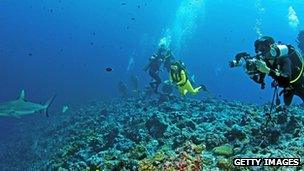Scientists warn of ocean conservation in wrong areas
- Published

Research suggests the relatively small numbers of species in the UK's coastal waters mean they are more affected by issues like pollution and over fishing
Attempts to maintain biodiversity in the world's oceans could be targeting the wrong areas, with the seas around the UK as important as coral reefs.
That is the findings of a new report by scientists from the universities of Dundee and Portsmouth.
They examined the importance of each species rather than simply counting the number of species in a given area.
They found areas with fewer species, like those around the UK, were more affected by issues like pollution.
The researchers claim the study, published in the journal Nature, external, challenges conventional wisdom about what biodiversity means.
'Catastrophic collapse'
Professor Terry Dawson, from the University of Dundee, said: "Conventional global conservation priority has focused on tropical sites having high biodiversity richness in terms of species.
"In contrast, our research has shown that to maintain healthy, resilient marine habitats those regions with fewer species, such as found in the seas around the UK for example, may actually be more vulnerable to catastrophic collapse from human pressures such as pollution and overfishing."
Dr Trevor Willis, from the Institute of Marine Sciences at the University of Portsmouth, added: "Since the days of Darwin and Linnaeus, the number of different species in an ecosystem - what researchers call 'species richness' - has dominated the scientific view of global biodiversity patterns and has long been used as a biological basis for management of imperilled ecosystems.
"But just counting species is a very crude way of understanding diversity.

The number of species in an ecosystem often dictates its level of protection
"By gathering information on the animal's traits - what they eat, how they move, where they live - we can understand more about how they vary in terms of their function in the operation of natural ecosystems.
"This functional variation is really the essence of biodiversity."
The study was carried out by an international team of researchers from Australia, Chile, Indonesia, Italy, Spain, Sweden, the US and the UK.
They measured factors other than the traditional species count, such as a species' role in an ecosystem or the number of individuals of a particular species, revealing new hotspots of biodiversity, including some nutrient-rich, temperate waters.
The research team noted how the members of each of these species lived, using a detailed matrix of functional traits.
These included what the species ate (plankton, invertebrates, algae, other fish, or a combination), how they ate it (browsing, scraping, or predation), where they lived (in, on, or near the bottom, attached, or free-swimming), whether they were active at night or during the day, and how gregarious they were (solitary, paired, or schooling).
The information was collected through a "citizen science" initiative developed in Tasmania with recreational scuba divers trained to carry out the surveys.
'Temperate latitudes'
The researchers then analysed data from 4,357 standardised surveys at 1,844 coral and rocky reef sites worldwide.
The surveys spanned 133 degrees of latitude and found 2,473 species of fish.
The team said the findings had important implications for planning and management, particularly in regards to the marine protected areas (MPAs).
Lead author Dr Rick Stuart-Smith, of the University of Tasmania's Institute for Marine and Antarctic Studies, said: "Relatively few MPAs are located at temperate latitudes, particularly in the southern hemisphere, a bias accentuated in recent years with global focus on declaration of large tropical MPAs.
"Our results identify further unrecognised biodiversity value in some temperate and southern hemisphere regions, strengthening the argument for greater representation of these areas in global MPA protection."
Dr Willis added: "We should perhaps be having a harder look at how well higher latitude marine ecosystems - like around the UK - are being represented by no-take MPAs that enable us to see what relatively natural marine ecosystems should look like."
- Published30 August 2013
- Published25 July 2013
- Published23 July 2013
- Published12 January 2013